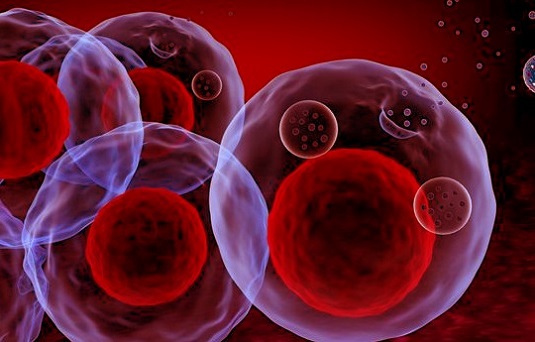Hidden Triggers Behind Long COVID Uncovered in Tiny Vesicles Floating in the Blood
Nikhil Prasad Fact checked by:Thailand Medical News Team Apr 22, 2025 2 hours, 37 minutes ago
Medical News: Long COVID Linked to Inflammation and Brain Damage via Microscopic Vesicles
Researchers from the Institute of Biomedicine of Seville (IBiS)-Spain, Virgen del Rocío University Hospital-Spain, the Spanish National Research Council (CSIC), University of Seville-Spain, and Lund University in Sweden have discovered alarming evidence that Long COVID symptoms are tied to lingering inflammation and possible nerve damage—caused by microscopic particles called extracellular vesicles (EVs). These particles are released by cells and travel through the bloodstream carrying cargo that may continue to harm the body even more than a year after COVID-19 infection.
 Hidden Triggers Behind Long COVID Uncovered in Tiny Vesicles Floating in the Blood
Hidden Triggers Behind Long COVID Uncovered in Tiny Vesicles Floating in the Blood
Despite global vaccination campaigns and a decline in severe COVID-19 deaths, a troubling percentage of people—about 10.4%—continue to suffer from lingering symptoms like fatigue, brain fog, depression, and breathing issues months or even years after their initial infection. This
Medical News report uncovers new evidence suggesting that damage seen in Long COVID might not be random but actually linked to these tiny biological messengers known as EVs, which appear to fuel a long-term inflammatory response and possible neurological damage.
What the Study Looked At
The research team studied 20 people who had recovered from COVID-19 at least 15 months earlier and compared them to 13 healthy individuals with no known history of SARS-CoV-2 infection. Both groups were similar in terms of age and sex. Participants underwent immune system tests, blood analysis, memory assessments, and even colon biopsies.
What stood out was that even though the former COVID-19 patients had clinically “recovered,” their immune systems told a different story. Many had lower levels of white blood cells, particularly neutrophils—a key immune cell used to fight infections. Even more striking, many of these patients still had neurological complaints, including fatigue, memory issues, and depression.
EVs Reveal Hidden Inflammation and Brain Damage
Though standard blood tests didn't reveal much, a deep dive into extracellular vesicles—especially those derived from neurons—painted a more alarming picture. COVID-19 survivors had significantly higher levels of neurofilament light chain (NfL), a marker of nerve damage, inside these vesicles.
Additionally, while inflammatory cytokines (proteins that regulate immune responses) weren’t elevated in the blood plasma, their concentrations were noticeably higher inside EVs. Molecules like IL-18 and MIP-1b—known to contribute to chronic inflammation and cognitive issues—were significantly increased. These findings suggest EVs may act like stealthy delivery vehicles for inflammation, avoiding detection in typical tests but still doing damage.
t;Immune System Still Disrupted Long After Recovery
The immune system changes did not stop at EVs. Researchers found abnormal behavior in three key immune cell types: monocytes, T-cells, and dendritic cells.
Monocytes from COVID-19 survivors were hyperreactive. When stimulated in the lab, they produced excessive levels of inflammatory molecules such as IL-6 and TNF-alpha, two markers commonly linked with severe infections and chronic illness. However, despite this high output, these monocytes showed reduced overall response versatility, pointing to immune system exhaustion.
CD4+ T-cells—a type of immune cell that helps coordinate responses—also showed signs of ongoing activation. These cells were still expressing markers that should have normalized long after recovery. Meanwhile, CD8+ T-cells, which kill infected cells, were unusually low in “senescent” (aged and worn-out) states, suggesting abnormal turnover or chronic stimulation.
Dendritic cells (DCs), which are crucial for triggering immune defenses and keeping inflammation in check, showed diminished activity. Levels of IDO, an enzyme important for immune tolerance, were decreased across multiple DC subtypes. On the other hand, some dendritic cells were expressing more of a molecule known as b7-integrin, which may help them migrate to the gut.
Gut Tissue Still Harbors the Virus Nearly a Year Later
Perhaps one of the most astonishing findings was that colon tissue still contained traces of SARS-CoV-2 proteins up to 297 days after infection. This suggests the virus may persist in certain tissues, long after nasal swabs come back negative. These hidden reservoirs might be what keeps the immune system activated and inflamed for months on end.
What This Means for Long COVID Sufferers
These results raise critical concerns. They show that in some people, SARS-CoV-2 leaves behind not only symptoms but also long-lasting disruptions in how the immune system and nervous system function. The fact that tiny particles like EVs can continue to spread inflammation and carry markers of nerve damage more than a year after infection challenges the notion that recovery from COVID-19 is ever truly complete.
Why This Matters
Millions of people worldwide are grappling with Long COVID. The findings from this study highlight the urgent need for targeted therapies that can interrupt this prolonged inflammation. By focusing on EVs, researchers may have found a new way to track and potentially treat neurological and immune-related symptoms of Long COVID before they worsen or become permanent.
Conclusion
The study provides powerful evidence that extracellular vesicles act as a hidden vehicle for inflammation and nerve damage in people suffering from Long COVID. While standard blood tests may suggest a patient is fine, these vesicles quietly carry damaging molecules through the body, potentially explaining why symptoms persist for so long. The immune systems of these individuals also show lingering dysfunction—with immune cells either overreacting or burning out—raising serious concerns about the long-term health risks associated with SARS-CoV-2 infection. This research opens the door to new diagnostic tools and treatment strategies that could focus on blocking these vesicles or restoring immune balance. As we continue to uncover the many layers of COVID-19’s aftermath, this study highlights how much more we still need to understand about its long-term effects on the human body.
The study findings were published in the peer reviewed journal: Frontiers in Immunology
https://www.frontiersin.org/journals/immunology/articles/10.3389/fimmu.2025.1501666/full
For the latest COVID-19 News, keep on logging to Thailand Medical News.
Read Also:
https://www.thailandmedical.news/news/cambridge-study-finds-sars-cov-2-damages-brain-stem-contributing-to-long-covid-issues
https://www.thailandmedical.news/news/study-links-certain-long-covid-symptoms-to-disruptions-in-cholinergic-neurotransmission
https://www.thailandmedical.news/news/persistent-immune-chaos-lingers-one-year-after-covid-19-infection-and-fuels-long-covid-and-lung-damage
https://www.thailandmedical.news/articles/long-covid
https://www.thailandmedical.news/pages/thailand_doctors_listings
